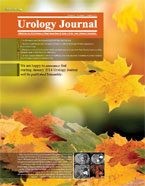Use of Desipramine for the Treatment of Overactive Bladder Refractory to Antimuscarinic Therapy
Urology Journal,
Vol. 10 No. 4 (2013),
4 January 2014
,
Page 1114-1118
https://doi.org/10.22037/uj.v10i4.1638
Abstract
Abstract
Purpose: To evaluate the use of desipramine in the treatment of overactive bladder (OAB).
Materials and Methods: We retrospectively evaluated 43 patients who were treated with desipramine for OAB refractory to antimuscarinic therapy. These OAB patients were stratified
by the presence or absence of bladder pain.
Results: Forty-three patients were evaluated with a mean follow up time of 12.2 ± 4.6 months. The mean age of the patients was 71 ± 16 years. Twelve patients (28%) discontinued desipramine, 9 due to perceived lack of efficacy, 2 due to central anticholinergic side effects, and 1 due to the development of oropharyngeal sores. Patients were stratified into two subgroups
based upon treatment with desipramine for OAB alone (n = 29) or OAB and bladder pain (n = 14). There was no difference between the groups in regard to sex (P = .34), prior history of radiation (P = .19), side effects (P = .16), and specifically evaluated central anti-cholinergic side effects (P = .66). There was no statistical difference in the self-reported success rate of the medication (P = .48). In the OAB plus bladder pain subgroup, 71% of patients reported improvement in their pain. Overall, 13 (30%) patients had history of prior pelvic radiation and 10 of those (77%) reported improvement with desipramine.
Conclusion: Desipramine is a potential useful treatment for patients with OAB. In addition, it can be used in patients with OAB and bladder pain and patients with complex OAB such as OAB caused by pelvic radiation.
How to Cite
- Abstract Viewed: 306 times
- PDF Downloaded: 467 times
